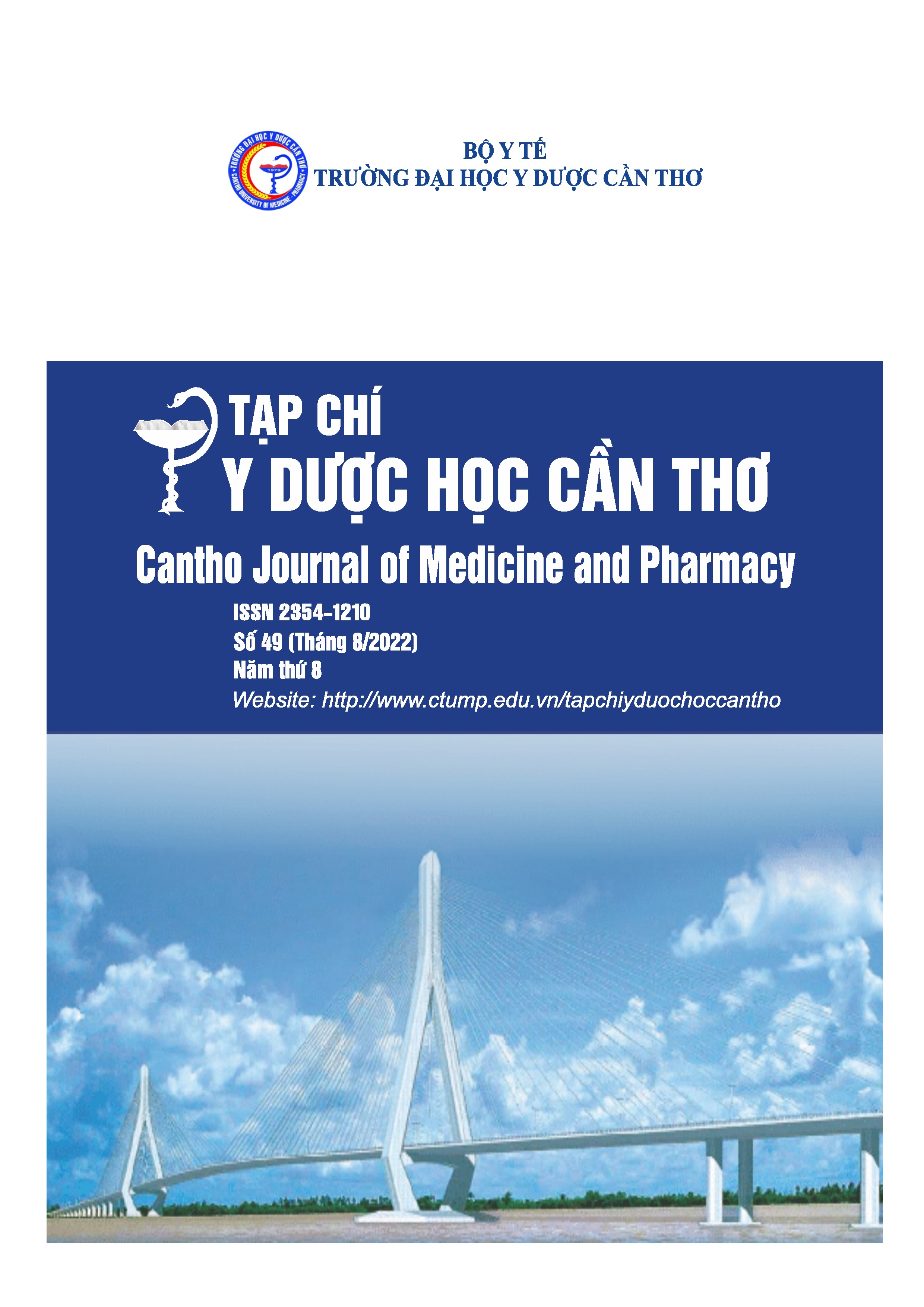STUDY ON CLINICAL FEATURES AND EVALUATION OF TREATMENT RESULTS OF THE WOMEN CYSTOCELE BY USING TRANSOBTURATOR SUBVESICAL MESH AT CAN THO CENTRAL GENERAL HOSPITAL AND CAN THO UNIVERSITY OF MEDICINE AND PHARMACY HOSPITAL
Main Article Content
Abstract
Background: A cystocele is a condition in which supportive tissues around the bladder and vaginal wall weaken and stretch, allowing the bladder and vaginal wall to fall into the vaginal canal. Cystocele can have a negative impact on the quality of life, affecting daily functioning by causing the symptoms like feeling of pressure or sensation that something is bulging or about to come out of the vagina, infection or low urinary symptoms then the surgical treatment is required. Objectives: To describe the clinical feature and evaluate the treatment result of the woman cystocele by using tranobturator subvesical mesh. Materials and methods: This is a cross-sectional descriptive study of 46 female patients with cystocele grade II or higher (POP-Q) between 2020 Jan to 2021 December at The Hospital of Cantho University of Medicine and Pharmacy and Can Tho Central General Hospital that treated by using transobturator subvesical mesh. Results: There were 46 patients. The mean age was 65.5±8.7 (38-82), rate of menepause patient is 95.4%, case that birth 3-4 times is significantly highest 65.2%, 100% patient has LUTS. The mean time of operatine was 49.1± 6.5min (35-60). The success rate of good recovery (based on POP-Q scale and low urinary symptoms) is 100%. No complications occurred during surgery and after surgery. Conclusion: Transobturatior subvesical mesh is highly feasible, safe and effective for the treatment of cystocele. This procedure is simple, mini invasive with low morbidity and high effective. In 46 case studied, there were no cases of complications during and after surgery. The rate of success post-operative of transobturator subvesical mesh surgery was approximately 100%. Meanwhile, it should be continued to peform and evaluate the result with long time and larger data .
Article Details
Keywords
Cystocele, transobturator subvesical mesh
References
2. Nguyễn Bá Mỹ Nhi (2011), “Đánh giá bước đầu phẫu thuật điều trị sa tạng chậu nữ có đặt mảnh ghép tổng hợp tại Bệnh viện Từ Dũ”, Tạp chí Y học thành phố Hồ Chí Minh, số 2, tr.3-9 . 3. Vũ Hồng Thịnh, Đỗ Anh Toàn (2003), “Phẫu thuật sửa thành trước âm đạo trong điều trị sa bàng quang ở phái nữ”, Tạp chí Y học thành phố Hồ Chí Minh, số 1, tr.96-10 .
4. Trần Thụy Khánh Vân (2021), “Nghiên cứu kết quả điều trị sa tạng chậu nữ bằng phẫu thuật đặt mảnh ghép đường âm đạo tại Bệnh viện Sản nhi An Giang năm 2020-2021”, Luận văn tốt nghiệp Bác sĩ chuyên khoa cấp II, Trường Đại học Y Dược Cần Thơ
5. Nguyễn Trung Vinh, Lê Văn Cường (2012), “Đánh giá kết quả sớm phẫu thuật đặt mảnh ghép qua ngả âm đạo điều trị sa tạng chậu nữ”, Tạp chí y học thành phố Hồ Chí Minh, số 2, tr.290295.
6. Adhoute F., Soyeur L., Pariente J.L., Guillou M.Le, Ferriere J.M. (2004), “Use of transvaginal polypropylene mesh (GyneMesh) for the treatment of pelvic floor disorders in women. Prospective study in 52 patients”, Program Urology, 2, pp.192-196 .
7. De Tayrac R, Deffieux X., Gervaise A., Chauveaud A., Fernandez H. (2006), “Long-term anatomical and functional assessment of transvaginal cystocele repair using a tension-free polypropylene mesh”, International Urogynecology Journal and Pelvic Floor Dysfunction, 5, pp.483-488 .
8. Fekete Z., Kőrösi S., Pajor L., Bajory Z., Németh G., Kozinszky Z. (2018), “Does anchoring vaginal mesh increase the potential for correcting stress incontinence?”, BMC Urology, 1, pp.33.
9. Jack CW, Joanna MT et al. (2012), Campbell-Walsh Urology, Elservier 10th edit, pp.2069-2081.
10. Patil P, Patil A (2013), “Evaluation of pelvic organ prolapse in Indian females”, Journal of Evolution of Medical and Dental Sciences, 2, pp.7612-7620.
11. Weber AM, Abrams P, Brubaker L, Cundiff G, Davis G, Dmochowski RR, et al. (2001), “The standardization of terminology for researchers in female pelvic floor disorders”, Int Urogynecol J Pelvic Floor Dysfunct, 3, pp.178-186 .
2. Young SB (2001), Vaginal paravaginal repair: One-year outcomes, Am J Obstet Gynecol, 185, pp.1360-1367.


